Healthy Built Environment
What is the built environment?
The built environment is our physical or human-made surroundings that provide the backdrop of our daily lives. This ranges from buildings, parks, businesses and schools to road and transportation systems and other infrastructure that we come across living and working on a day-to-day basis.
How is the built environment connected to our health?
There is a connection between the built environment and factors influencing our health. These include physical activity, injuries, nutrition, air pollution, climate change, water quality, risk of traffic collision and community social networks.
Healthy community design creates healthy, sustainable and complete communities. It recognizes the value of protecting the natural environment, reducing community exposure to health hazards, opportunities for increased physical activity and recreation; access to healthy food choices; social equity and cohesion; safety and security and our aging and diverse population.
To learn more about the connection between health and the built environment and how residents can participate in building healthier communities, Ottawa Public Health has produced the following My Community, My Health videos:
BC Provincial Health Services Authority’s Healthy Built Environment Linkages report includes a framework for understanding the key relationships between the built environment and health. According to this framework, health outcomes can be closely linked to:
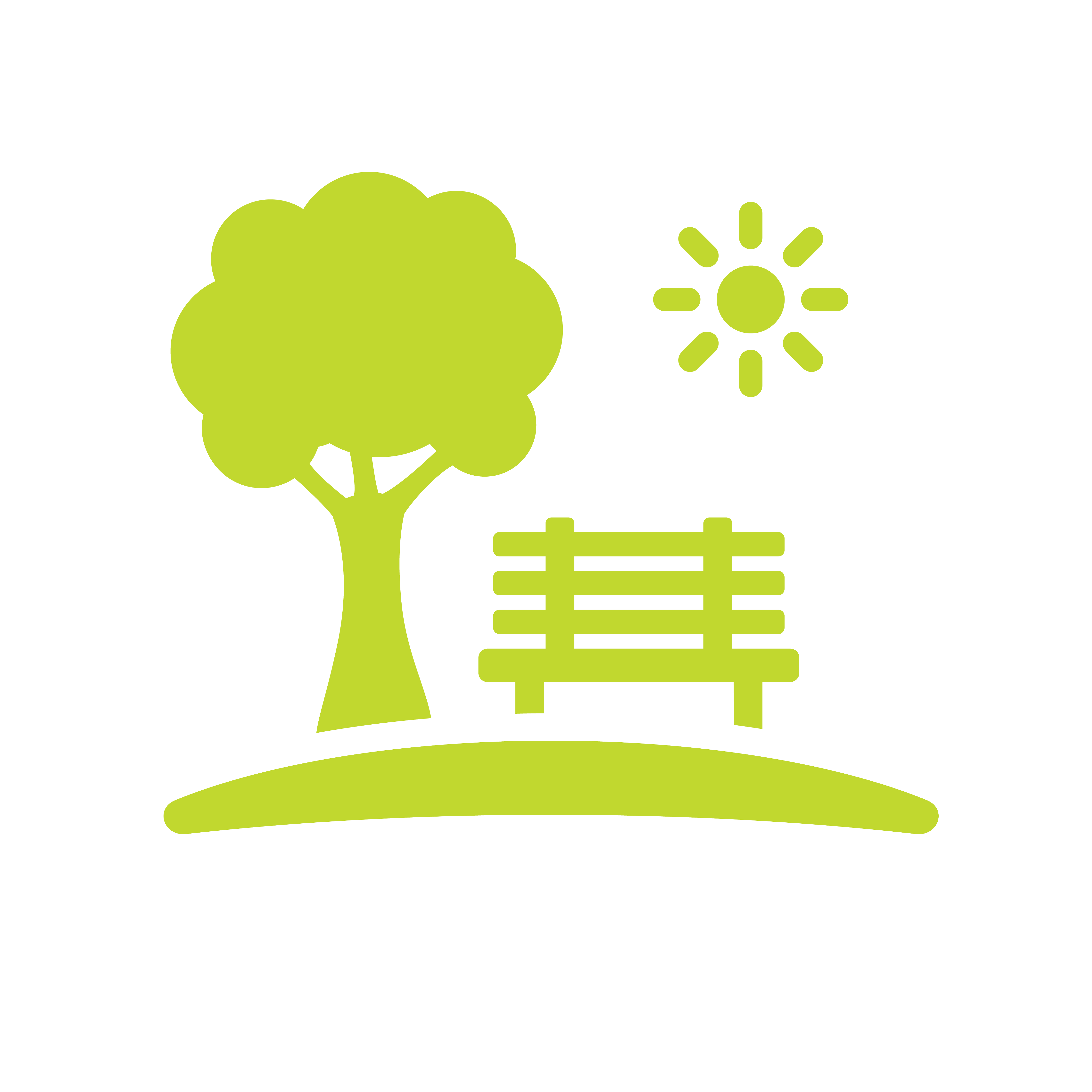
Natural Environment
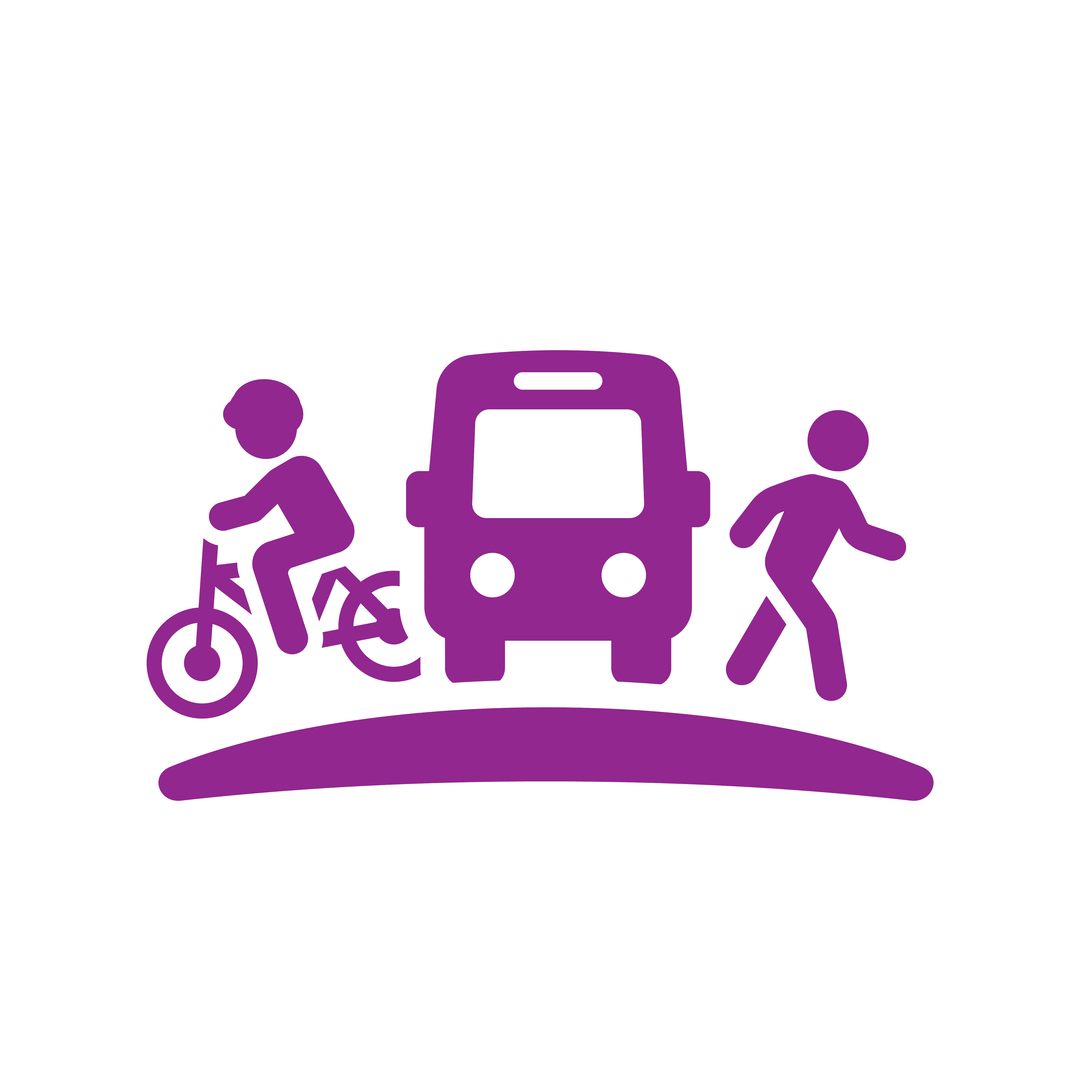
Transportation Networks
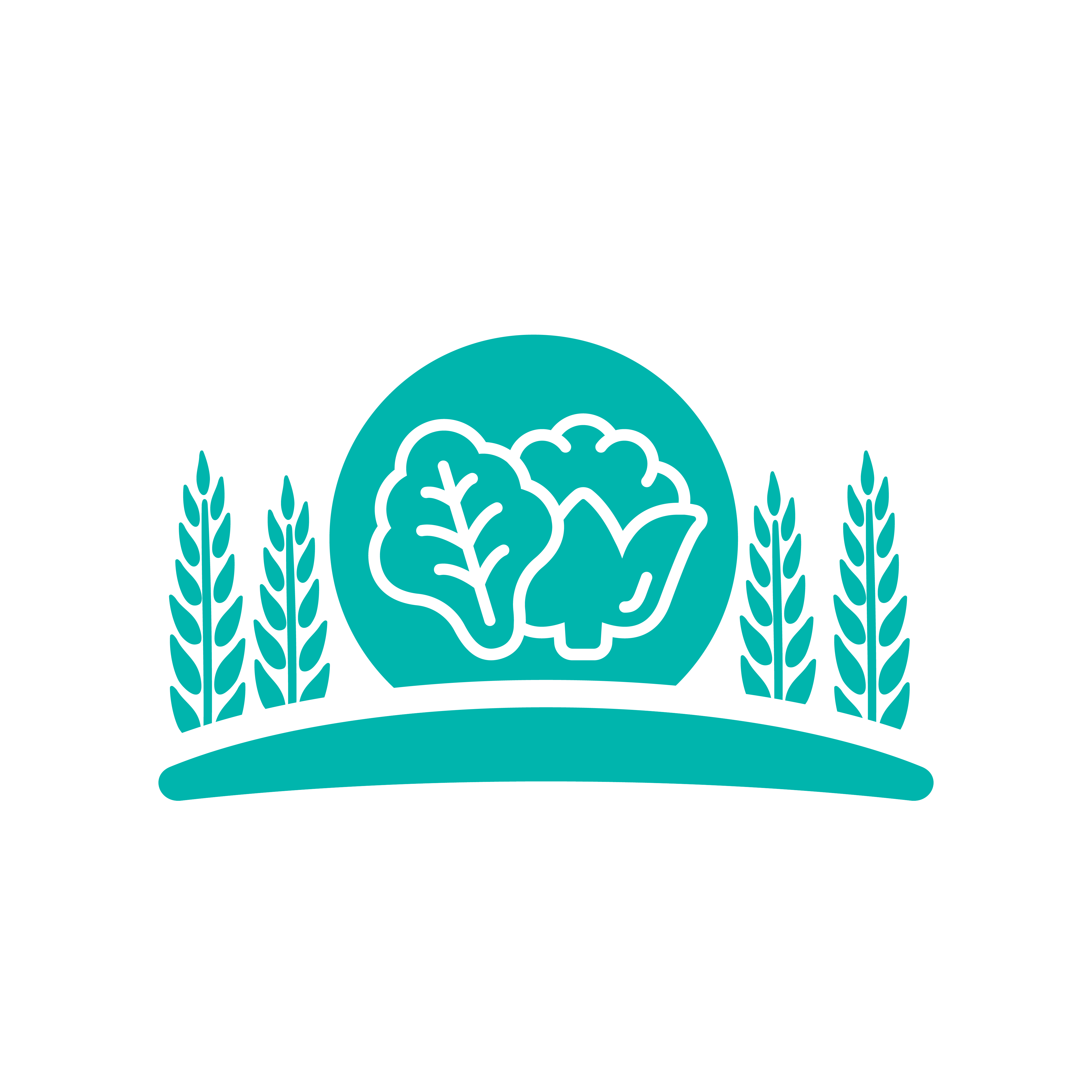
Food Systems
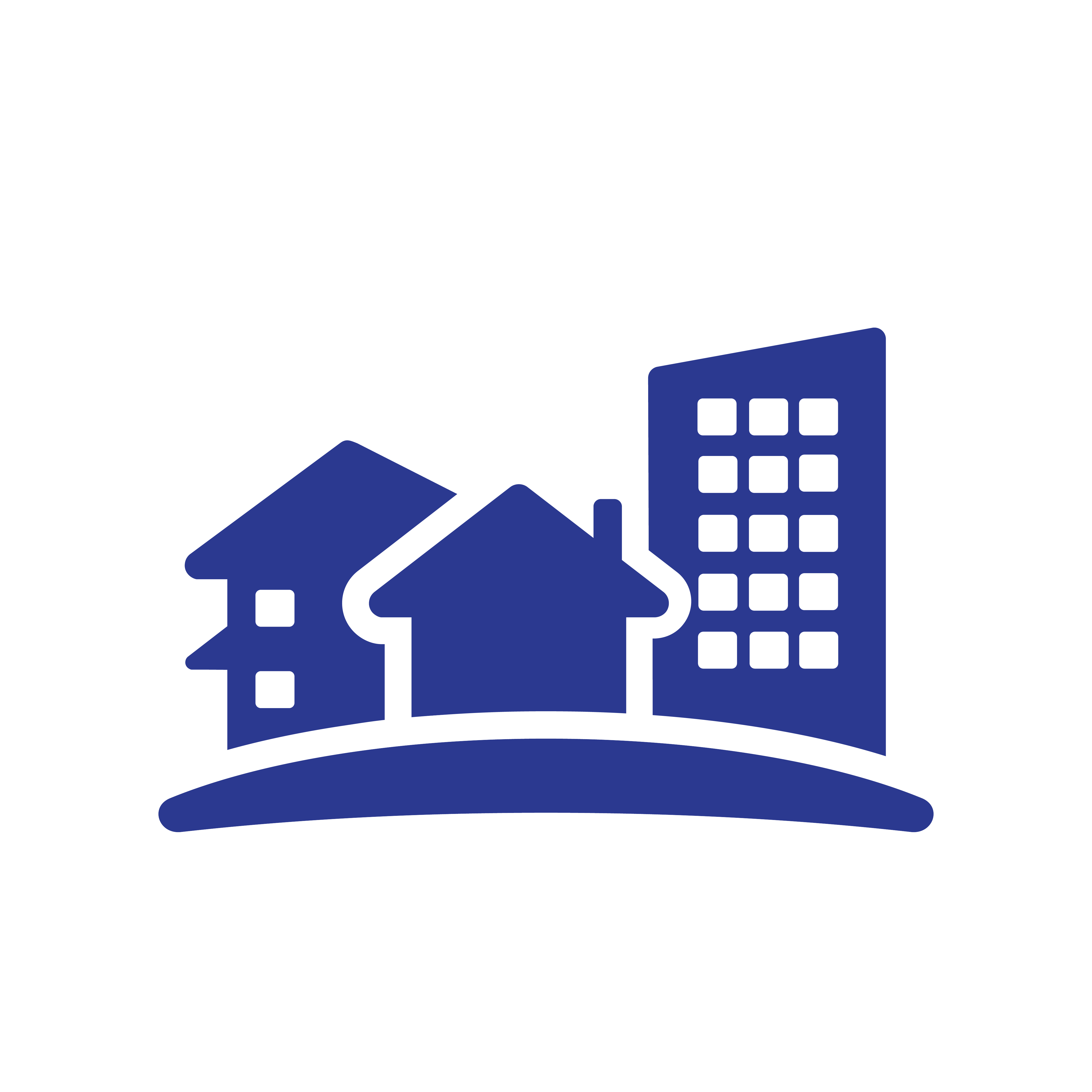
Neighbourhood Design and Housing
Sustainable Food Systems

| What it is | Green spaces often refers to land that has vegetation, natural elements, is available to the public and can include parks, gardens, forests, trails where there’s vegetation such as grass, trees and plants. In urban environments this may include streetscapes and green roofs.
|
|---|---|
| Why it matters | The health of the natural environment is linked to human health. Trees, plants and green spaces remove air pollution from the environment; they provide shade and cool and improve air and water quality. Communities that support walking and have accessible community spaces (parks, trails, etc.) increase levels of physical activity and promote social connection. |
| How it impacts health | Spending time being active in nature can improve concentration and memory, reduce anxiety, and promote mental health. It can reduce the risk of chronic diseases including diabetes and heart disease. Green spaces contribute to healthier environments by improving air and water quality, reducing flood risks, providing natural shade and cooling our communities, and helping to address climate change. 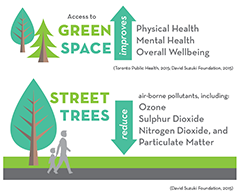
|
| What are we doing about it | York Region is involved in a number of initiatives such as:
|
| What can you do | Tap into the benefits of green spaces and the natural environment by taking a walk outdoors and visiting a nearby park, trail, forest or garden. York Region has more than 50 trails for you to explore. Other activities include:
|
| Resources/references |
Sustainable Food Systems

| What it is | A built environment with a local sustainable food system is one that:
|
|---|---|
| Why it matters | Our food system, which includes the way food is grown, processed, transported, marketed, consumed, and wasted, needs to be enhanced. Unhealthy foods are available everywhere: in stores and community settings (e.g., workplaces, recreation facilities, schools) resulting in unsupportive environments. Some people have challenges accessing grocery stores (e.g., no stores in their community, lack of transportation, mobility issues), making it difficult to support healthy eating. Canadian diets are generally low in vegetables and fruit and high in saturated fat, salt and sugar, increasing the risk for chronic disease (e.g., heart disease and some cancers). Poor food literacy, including a lack of knowledge and skills to plan, purchase and prepare foods and healthy meals, may be contributing to poor diets. Food waste not only costs Canadian consumers approximately $1,500 per year but contributes the equivalent of over 55 million tons of carbon emissions annually. A built environment that supports a sustainable, local food system will allow residents to make healthy choices for physical, mental and planetary health. Improving the food environment can improve nutrition. The local food environment can be improved by increasing the number and quality of food retailers and restaurants in underserved areas. Food policy can improve nutrition by reducing or removing high-fat and high-sugar foods in institutional settings such as schools. Local growing and selling of culturally appropriate foods, such as ethno-cultural vegetables, contributes to healthy diets among immigrant populations. Communities designed with food access in mind can result in improved food security for everyone. |
| How it impacts health | Access to safe, dependable, affordable and healthy food along with a sustainable food system, improves the physical and mental health of an individual and the well-being of the community. Everyone should have equitable access to healthy, and culturally appropriate food that meets their dietary needs and food preferences. The way our communities are planned and designed can impact food access and availability and influence health outcomes. |
| What are we doing about it | Dietitians and Regional staff work to support a healthy local sustainable food system by promoting:
|
| What can you do | Ask grocery stores, restaurants and other publicly operated organizations to provide affordable local, healthy food options. You can gradually shift your eating habits to include more plant-based sustainable foods to improve your physical health and planetary health. A sustainable diet:
When possible, purchase local food to support the local food system and climate change mitigation, contribute to the local economy, and increase your community connections. You can also participate in community, roof top or other shared gardens to make your community more self-sufficient, beautiful and friendly. Additionally:
|
| Resources/references |
Transportation Networks

| What it is | A well-designed sustainable transportation network is safe, accessible, attractive and prioritizes active transportation options like walking, cycling, and using public transportation.
|
|---|---|
| Why it matters | People who use sustainable transportation – whether public transit, walking, cycling, or a combination – have lowered risk of cardiovascular disease, cancer, respiratory disease and mental health concerns and are on average healthier when compared to those who rely completely on a personal vehicle. Among commuters, car users may face the highest health risks. A daily round trip of as little as 30 kilometers has been linked to greater likelihood of being overweight, inadequate physical activity and feeling stressed. There are also emerging concerns of a higher risk of dementia linked to both inactivity and exposure to traffic-related air pollution. York Region residents made 2.1 million trips daily in 2016, and 78 per cent of these were by automobile. Road design has an impact on how we move around. It influences if, and when people cycle, walk or drive and how safe they are when they take part in these activities. Since active transportation is more affordable than car ownership, communities also experience improved equity and access to services such as healthcare, education, and employment opportunities (Healthy Built Environment Linkages, 2018). |
| How it impacts health | A transportation network that promotes active and non-motorized transport for commuting and daily activities creates more accessible, sustainable, equitable, inclusive and healthy communities. 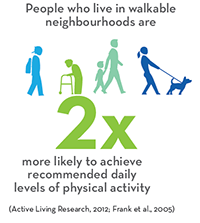
Prioritizing the supply of dedicated cycling and walking infrastructure can help create safe environments for persons of all ages by decreasing the number of vehicles and reducing the risk of collision (BE&H Action Plan pg. 26). Increased rates of vehicle use can contribute to decreased physical activity, higher rates of childhood obesity and increased traffic related air pollution. When physical activity is integrated into daily commuting, residents are more likely to experience improved health, better physical and mental well-being, and a greater sense of connectedness to their community. With less vehicles on the road, our environment also experiences positive benefits like lower greenhouse gas emissions, and reduced traffic related air pollution. 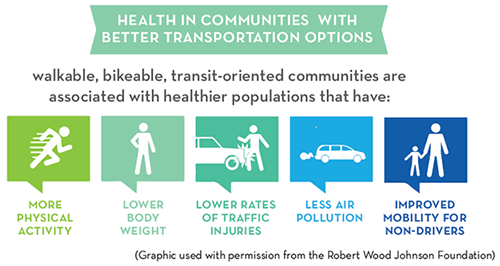
|
| What are we doing about it | York Region is enhancing active transportation and rapid transit infrastructure through the Transportation Master Plan and Lake to Lake Cycling Route. York Region and partners are supporting cyclists by building and funding bike lanes, multi-use paths and trails, while also delivering campaigns and programs to promote education and safety. |
| What can you do | Get to know your local community. Take transit, carpool, car share, cycle, or walk more often. Choose an active option especially for shorter trips. The journey to and from school is a great opportunity to use active transportation. Active school travel contributes to healthier students, safer school zones, less air pollution, and better academic performance. |
| Resources/references |
Neighbourhood Design and Housing

| What it is | Neighbourhood design and housing are reflected in the planning decisions that impact the layout of a community, the services, amenities, and infrastructure available for all ages, stages, and abilities, including diverse and affordable housing along with how complete, compact and connected the community is. Connected communities have interconnected and accessible mobility systems that provide the ability to walk, cycle, transit, and carpool. They offer a priority on pedestrian movement and transit use and access, and include a system of pedestrian and bicycle paths. |
|---|---|
| Why it matters | It is the policy of York Region Council: That communities shall be designed in a manner that fosters physical and mental health, facilitates inclusivity and accessibility for people of all ages and abilities, and York Region’s diverse population. It is also recognized that well-designed communities positively impact human health. The accessibility and quality of supportive housing options is also related to improved health and social well-being (Healthy Built Env. Linkages, 2018). |
| How it impacts health | The way a community is designed can influence residents’ access to healthy choices and opportunities (e.g., clean air and water, fresh food markets, grocery stores, recreational facilities, trails, parks, etc.) and unhealthy choices and opportunities (e.g., air pollution, access to alcohol, tobacco, fast food). Climate change impacts the health of our communities. It may lead to more heat waves, severe storms, flooding and diseases, and it can affect our food supply. Planning our communities to be more resilient and sustainable will help prepare for and adapt to the impacts of climate change. |
| What are we doing about it | York Region is Building Healthy, Complete Communities. 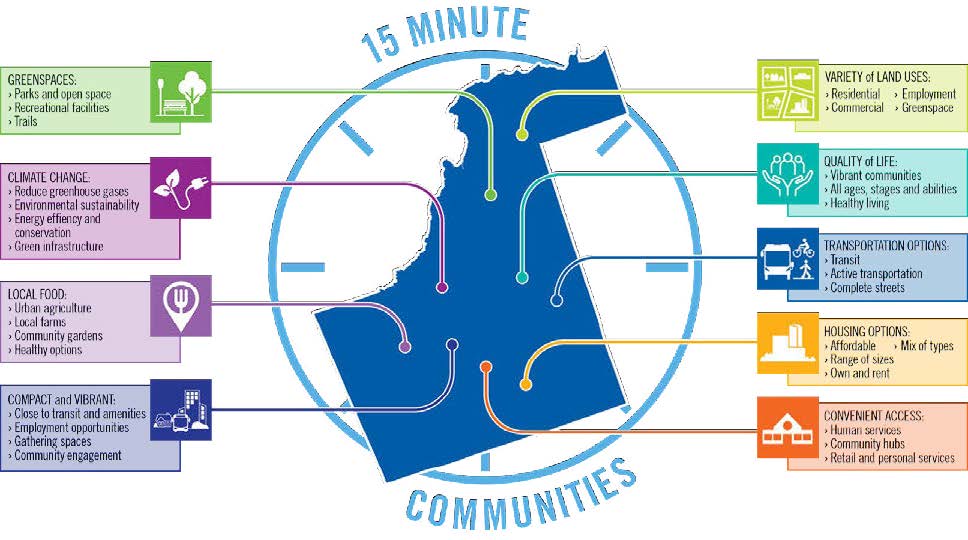
Complete Communities:
(From: Shaping the Future: Building Complete Communities in York Region). Public Health has supported building healthy, complete communities by strengthening partnerships with Regional and local municipal partners through the provision of health data and information, technical advice on planning and transportation infrastructure development projects, and by assisting in land use policy and development review processes. |
| What can you do | Get to know your community. Walk or cycle more often and use your car less. You can:
|
| Resources/references |
Planning for Complete and Inclusive Communities
Building complete communities means every person, regardless of age, ability, lifestyle or stage of life and background, can live, work, play and thrive in York Region. We plan so that everyone can bring their unique identities and work together to create the strong, caring, and safe communities that make up York Region. Building complete and inclusive communities is the objective of the Plan.
Built Environment and Health Action Plan
In response to the strong linkages between planning, design and human health, York Region Public Health has developed a Built Environment and Health Action Plan (Action Plan Primer, 2017). The Action Plan aims to support the development of community, transportation, and land-use planning policies and practices to create a healthier York Region.
In addition to reviewing plans, policies and legislation, York Region Public Health supports many initiatives that promote a healthy built environment including:
- Seniors Strategy
- Pedestrian and Cyclist Safety
- York Region Transportation Master Plan
- Greening Strategy and the Forest Management Plan
- Housing Supply Action Plan
- School Travel
- York Region Food Charter
- Regional Climate Change Action Plan
- Climate Change and Health
- York Region Municipal Comprehensive Review
- Physical Activity
How to get involved
There are a number of ways for individuals to get involved in the built environment, including:
- Learn about the York Region: Regional Official Plan
- Learn more about your municipality’s official plan and how it affects your community
- Connect with your local municipality for public consultation opportunities
- Participate on a municipal or community committee
- Spread your knowledge on the built environment or refer others to appropriate resources
Related Resources
- Regional Municipality of York Council Report: Public Health Benefits of Complete Communities
- York Region: Built Environment and Health Action Plan Primer
- York Region: Green Space and Health (Fact Sheet)
Building Healthy Communities Factsheets
- Active Transportation
- Age Friendly Communities
- Air Quality
- Climate Change and Extreme Heat
- Food Access
- Greening Our Communities
- Healthy Communities
- Road Safety
- Water Quality
External Resources
- 8 80 Cities
- BC Centre for Disease Control: Healthy Built Environment Linages Toolkit
- Canadian institute of Planners (CIP-ICU): Healthy Communities
- Government of Canada: The Chief Public Health Officer’s Report on the State of Public Health in Canada
- Government of Canada: Mobilizing Public Health Action on Climate Change in Canada
- Healthy Canadians Healthy Living - Where We Live Matters (video)
- National Collaborating Centre for Environmental Health (NCCEH): Healthy Built Environment Online Discussion Forum
- National Collaborating Centre for Environmental Health (NCCEH): Built Environment Resources
- Ontario Public Health Association (OPHA): Built Environment Work Group
- Parachute: Vision Zero


